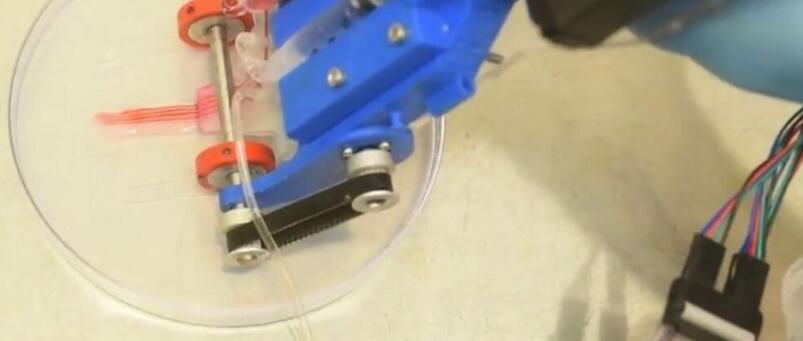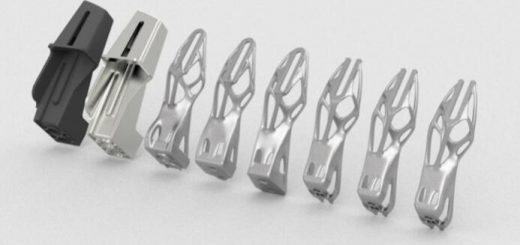3D Printed Skin: How is it Possible and What Has Been Made?
Bioprinting is not a technology picked up from a science-fiction story, it is now a reality for the medical sector. There are more and more 3D printing materials available on the market, but now it is also becoming possible to 3D print cells thanks to new efficient 3D machines.

These 3D bioprinters are able to recreate and grow cells from the actual stem cells of a patient. These bioprinting experiments are starting to revolutionize the medical field, it is becoming possible to 3D print body parts, organs, but also skin tissues.
![]() Skin transplant to save lives
Skin transplant to save lives
3D printing can definitely help to solve some of the problems that we have actually in the medical sector. For example, when a patient needs an organ for a transplant or a new skin tissue to heal an important wound, we have to wait for a donor.
Waiting for a donor is a long process, but these patients don’t really have time to waste. That is precisely where the additive manufacturing technology can help them: it can use the patient’s cells to create a functional organ, an organ part or now, even a brand new skin tissue!
This process could really help accident victims and burned patients by providing viable skin grafts. It will be a real time-saving technique, and it will considerably ease the whole process as only one machine will be required. Donors and additional surgeries will not be needed anymore.
![]() 3D printed skin to test chemicals
3D printed skin to test chemicals
3D printed skin can help to heal wounds, but that is not it. These new skin printers can help to save lives on other levels. Indeed, 3D printing human skin can be a great solution to test chemicals, and develop new medical treatments. By creating a 3D skin with the patient’s cells, it could even be possible to create a custom-made treatment for him, and to test it before!
This process could avoid testing cosmetics and chemicals on animals for example. Additive manufacturing will certainly help to solve some of these ethical problems with the development of functional skin tissue and living cells reacting just like natural ones.
3D printed skin: How is it possible and what has been made? For the moment, you will not be able to get your own skin 3D printer. But some really promising experiments let us dream about efficient skin 3D printers able to save millions of lives quite faster than what we can do today.
Here is a selection of impressive experiments made with 3D skin printers all around the world.
![]() 3D printing skin over wounds
3D printing skin over wounds
Here is an amazing skin 3D printer developed by researchers at the University of Toronto. This portable 3D printer is able to lay down strips of skin. It could be used to print directly skin on a patient.
To make this little bioprinter work, you will have to get cells and grow cells. This process can take time, that is why researchers are talking about using the stem cells of what we call a universal donor. It could be a solution to mass-produce cells compatible with all of the possible patients. This technology has to be improved, but the first experiments are promising, and showing that it is actually possible to use a small but efficient device to 3D print human skin.
![]() 3D printing functional skin
3D printing functional skin
Scientists from the Universidad Carlos III de Madrid (UC3M), Hospital General Universitario Gregorio Marañón, CIEMAT (Center for Energy, Environmental and Technological Research), in collaboration with BioDan Group, unveiled the prototype of a 3D bioprinter that can print functional human skin.
The bioprinter is able to recreate the natural structure of the skin, with different layers. An external layer to get protection for the external environment, the epidermis. There is also another thicker and deeper layer, the dermis. And the last layer is what gives elasticity and mechanical strength to the 3D printed skin, producing collagen thanks to fibroblasts.
This is still a prototype, but it could soon be used to help burned patients for transplant for example.
![]() Pigmentation for 3D printed skin?
Pigmentation for 3D printed skin?
Most of the time, the 3D skins don’t really look like a real skin even if it has been printed using real skin cells. These skin tissues don’t have the same characteristics as hair follicles or pigmentation.
Researchers and scientists at A*STAR’s Singapore Institute of Manufacturing Technology (SIMTech) and the Singapore Centre for 3D Printing (SC3DP) at Nanyang Technological University developed a pigmented skin made using a 3D skin printer. They created a uniform skin pigmentation using bioprinting to check the distribution of skin cells producing melanin, or melanocytes.
This could be a great progress for people in need of skin grafts, as there are a lot of different skin colors. Having a skin graft actually matching the skin of the patient will be a huge step for the medical industry. Indeed, it could improve the healing process for the patient.
![]() 3D printed skin on the market
3D printed skin on the market
Poietis is a French biotechnology company specialized in regenerative medicine. The company is about to commercialize Poieskin, a 3D bioprinted skin. They are the first to put skin on the market.
Poietis is offering partnerships to design and create tissues that will be adapted to any needs or any projects. They are actually working with big companies to develop 3D tissue models for research and therapeutic purposes.
Source: sculpteo




Recent Comments